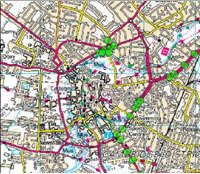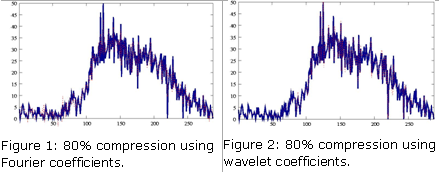|

Project Leader
Niki Trigoni
Project Participants
Antonios Skordylis
Alexandre Guitton
Project Collaborators University of Cambridge,
Birkbeck College
Project Details
Funder: EPSRC (Grant CSRP4)
Keywords
Sensor network, Traffic monitoring, Approximate data processing, Node placement, Energy-aware routing
|
Transport Information Monitoring Environment – Event Architecture and Context Management
The goal of the TIME-EACM project is to develop and deploy a sensor network that will monitor road traffic in the city of Cambridge. The network will be able to answer high-level queries based on raw sensor readings by extracting data from the sensors in an energy-efficient manner. Devising a node placement strategy is an important consideration.
We plan to answer several types of queries, including: “what is the fastest way to the closest post-office”, “what is the fastest way to any hospital”, “how long will it take to travel from A to B” and “what is the congestion on a traffic point”.
We have access to a real-time traffic dataset generated by an existing deployment of 160 inductive loop sensors in Cambridge. They produce flow and occupancy readings every five minutes. We are working towards reducing the communication overhead associated with propagating the results by utilizing approximate data processing techniques.

Single sensor (temporal correlations)
We are using Fourier and wavelet transforms to reduce time-series data (which correspond to a lossy compression). As shown on Figures 1 and 2, a small number of coefficients (20%) can provide a good approximation of the readings.

We use auto-correlation techniques to accurately predict the readings of today based on data from the previous days. This enables us to reduce the sampling frequency on the sensors.
Road traffic data is spatially correlated. We use the Pearson cross-correlation coefficient cf as a distance metric in order to group together nodes that exhibit very similar stream behavior. Nodes x and y are in the same cluster if their readings are heavily correlated (cf is close to 1) and if they are geographically close. When nodes are grouped together, some of the sensors can be deactivated (or even removed) and few values need to be sent to infer all the readings.
[1] N. Trigoni, Y. Yao, A. Demers, J. Gehrke, and R. Rajaraman. “Multi-Query Optimization for Sensor Networks”. In DCOSS 2005.
[2] N. Trigoni, Y. Yao, A. Demers, J. Gehrke and R. Rajaraman. “Hybrid Push-Pull Query Processing for Sensor Networks”. In WSN 2004.
[3] For the work in progress: http://www.dcs.bbk.ac.uk/~assent/
www.dcs.bbk.ac.uk/~assent/
|



